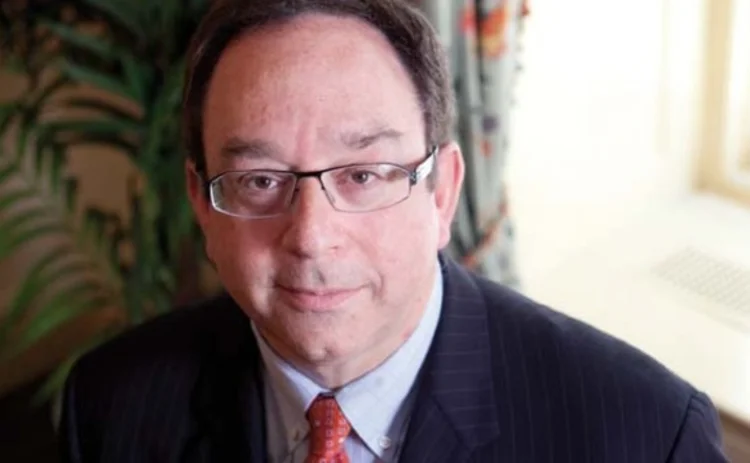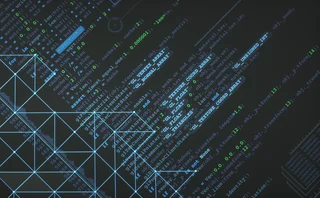On a Global Mission
The Waters Profile

It has been five years since Steve Rubinow joined the New York Stock Exchange and became its CIO. During that time the exchange has become more tech-centric, as it has evolved into a global force supporting multiple asset classes. NYSE Euronext is now set to unveil two new datacenters and is steadily migrating to a universal trading platform, as the exchange operator looks to become the center of the trading universe.
There is an air of nerdy-genius about Steve Rubinow, but don’t let that fool you—he is a risk-taker. He may not be a base-jumper or a free-diver, but he is not afraid of a bit of craziness. He has, after all, hiked Mt. Everest.
Rubinow was what you would call a wunderkind, driven and never feeling content—he holds a BS, an MS and a PhD in chemistry, and an MBA in marketing and finance from the University of Illinois, in addition to an MS in computer science from DePaul University. Needless to say, when it comes to his brain, there is not a lot of downtime.
Flash back to 1998, when the dot-com industry was about to spectacularly take off. Rubinow was at Fidelity Investments in a comfortable job that he liked. He had come a long way from where he grew up, in Chicago’s Rogers Park, sandwiched between Interstate 94 and Lake Michigan.
Rubinow doesn’t fear change and he doesn’t back down from a challenge. He left Fidelity, where he was in charge of developing its firm-wide architecture, to get in on the ground level of Silicon Valley’s meteoric rise. His boss at Fidelity thought he was crazy, and perhaps rightfully so. Why would you leave a job at a secure institution to chase the internet craze?
Rubinow was drawn in by the allure of it all. He loved to listen to technologists who reminisced about being involved from the beginning of the PC explosion 20 years earlier. “I didn’t know where the next era of craziness was going to come from, but I knew I wanted to live through that,” Rubinow says.
First, the Chicagoan went to a Palo Alto-based company called AdKnowledge. He was the CIO charged with increasing server and network capacity. By 2000, he left AdKnowledge, soon after a successful initial public offering (IPO) in 1999, to join a company a few miles north in San Francisco called NextCard, where he would become the CIO and CTO. He quickly transformed a staff of 150-plus and was noticed by Archipelago Holdings, which was based out of his hometown of Chicago. By 2001, Rubinow was the CIO of the Archipelago Exchange (ArcaEx).
In March 2006, Archipelago merged with the New York Stock Exchange (NYSE). Rubinow took a gamble when he left Fidelity for the Wild West, but he believes the bet paid off: He is now the CIO of the largest exchange on the planet.
At the time of Rubinow’s arrival, NYSE had long been the stodgy exchange of Wall Street. Less than five years later, it is now a multi-asset-class trading behemoth with a wingspan that envelops the globe. It is in the process of going live with two new state-of-the-art datacenters and is the on the cutting edge of cloud computing.
Now the hard part: creating one, unified exchange.
It Begins With a Small Cloud
One of the first things you notice about Rubinow, now in his 50s—though he declines to reveal his age—is that he is a thinker who doesn’t get much sleep. Dividing his week between New York and his native Chicago, he keeps his BlackBerry next to his bed and his co-workers must be prepared to receive e-mails at 3 a.m. and any time thereafter and before. It is a constant ebb and flow of excitement, especially when new ideas come to him. And much in the same way that he was there for the start of the dot-com resurrection, he is at the center of cloud computing’s evolution. It’s enough to keep anyone up at night.
The industry, much less an exchange, is not yet ready to move over to a true cloud model. However, NYSE is working toward client-specific clouds that are fully tailored and individualized—little, individual clouds, if you will.
“Conceptually speaking, I’d like our customers to think of us as an exchange cloud,” Rubinow says. “Now, technologically speaking, that is very hard to do. If you were going to go to the true cloud concept, where a trade can be executed anywhere in the world, it takes time for an electron to get from point A to point B. So for that reason, we can’t create a true, worldwide cloud environment, because everyone wants to know how long a trade is going to take and when you are dealing in microseconds, the cloud becomes less useful.”
While the cloud concept will not be at the core of the NYSE offering—mostly because of the industry’s obsession with speed and latency—it is a start. Cloud won’t be incorporated where latency is egregious, such as for virtualization, says Rubinow. “The time-cost of putting that extra layer, called virtualization, on top is prohibitive; we can’t do it.”
But NYSE is currently in the midst of building datacenters outside London and Manhattan. The exchange operator plans to tell its customers that they will be able to create custom clouds tailored to individual clients—they will have unique attributes; they won’t be general-purpose clouds—where the exchange handles all the software-as-a-service (SaaS), platform-as-a-service (PaaS) and infrastructure-as-a-service (IaaS) needs of a client and latency issues are overcome due to the localization of that particular datacenter.
“We are offering a set of services. It is not cloud-like because customers know exactly what they are connected to and it is not obscured by some abstraction layer—but we are going to get there,” he says. “We have this wonderful facility in New Jersey and its sister outside London, and that is where the two centers of activity are going to be. We will create an environment that supports those things.”
And this could be the first step to a truly revolutionary concept: an exchange with transient listings that migrates from market to market based on the peak hours of trading. Rubinow says this is not in NYSE Euronext’s plans at the moment, but others feel that this is not out of the realm of possibility.
Donato J. Cuttone, senior managing director and vice chairman of New York-based brokerage Cuttone & Co., says 24-hour listings, or something close to it, will eventually happen.
“I think NYSE doesn’t see it as viable right now because they probably have a lot on their plate in terms of implementing the new architecture and infrastructure,” says Cuttone, whose family has traded on NYSE’s floor since the 1960s. “But if we look way out on the horizon where the marketplace is going and what the overall trading landscape is going to look like, I do believe that will be the end game. Who comes out on top, I’m not sure, but I do firmly believe that NYSE has a strong advantage with what they are building out—they are the closest to doing it.”
One Exchange, One Platform
But as Cuttone explains, micro-clouds and migrating listings aren’t of pressing importance at the moment—NYSE has to deal with 24-hour technological and data-influx burdens as it has expanded in asset classes and geographies. While the future is cloud, the present is ensuring that NYSE Euronext is one, unified exchange.
At the center of this Universal Trading Platform strategy, which will allow NYSE to trade in all asset classes in all of its geographies, are two new gems: its datacenters in Mahwah, New Jersey, and Basildon, England.
In order for these datacenters to run efficiently and to ensure that support operates seamlessly across two continents, NYSE has been working to create an environment where operational and technology support in Europe can support the team in New York, and vice-versa, a model known as “following the sun.” Essentially, when an operations person walks into a facility—regardless of its location—he or she will feel at home: All the screens and applications look alike, and the protocols are identical. This way, anything that can be controlled with a wire and a screen can be supported from any facility on the globe.
“We have made a huge amount of progress in doing that,” Rubinow says. He explains that the universal trading platform, which went live in Europe last year, is being rolled out in the US this year, and the exchange operator will complete the rollout in the European derivatives space by the end of next year. NYSE Euronext declines to reveal the cost of the conversion.
The exchange started by creating uniform trading engines, then moved to the gateways and is now close to finishing on the market data side. Next will be back-office functionality, Rubinow says. “Everything will be global in nature—and, yes, there will be individual variations to accommodate local regulators and local business—but the core of what we do will be the same, look the same and behave the same across the globe, and it will be the best technology that we can possibly have to service our customers’ needs,” he says.
This is necessary because as the market continues to evolve, the exchange doesn’t want to be blindsided and find itself in need of another technological overhaul.
“I would be surprised if there were anything we do in the future—when it comes to the trading business—where we said: ‘No, the framework that we built won’t be able to accommodate that.’ We know we can accommodate it, it’s just a question of when the business wants to insert it,” Rubinow says.
A Technological Revolution
A clear sea change came with Rubinow’s arrival after the 2005–2006 purchase and integration of Archipelago Holdings. At the turn of the new millennium, the thought of NYSE being a leader on the ground floor of cloud computing would most likely have made people scoff.
“The exchange has come an awfully long way,” says Larry Tabb, founder and CEO of research firm Tabb Group. “If you look back five or seven years [before Rubinow took over], it was really an equity-execution exchange—they really weren’t multi-product, they didn’t have an options business, they weren’t global, and they didn’t have global linkages. But over the last five years they have been, truly, the global exchange brand.”
When NYSE resisted the move to automated trading in the early to mid-2000s, it allowed the Chicago Mercantile Exchange (CME) and London Stock Exchange (LSE) to gain ground, Tabb says. But NYSE has quickly re-grouped since Rubinow’s arrival, and former CEO John Thain, who arrived in 2004, deserves credit for this makeover as well. The exchange has also made several strategic purchases and partnerships over the past five years and has built out its Secure Financial Transaction Infrastructure (SFTI).
Fredrick Scuteri, senior vice president of prime brokerage services at Cuttone & Co., says NYSE has made a clear push to improve its technological capabilities, and agrees with Tabb’s assessment regarding the significant changes it has undergone over the past several years. In March, Cuttone was one of the first firms to move into NYSE’s new next-generation trading floor space, which has allowed the broker to move traders from upstairs down to the floor.
“Go back five years and the impression was that the floor was going to go away, that it is antiquated and not needed,” Scuteri says. “We are very excited that NYSE didn’t take this thing lying down—it reinvented itself instead of dying on the vine, and is full-speed ahead on the technology play.”
Tabb concurs: “NYSE is becoming a firm that looks at technology as a core aspect of its business rather than just a platform to trade; the thinking there has really radically changed,” Tabb adds.
It has been a case of growth through acquisition for NYSE, starting in 2006 with the merger of Archipelago, where Rubinow had been CTO since 2001. Then there was the Matchpoint Trading merger and a stake in Marco Polo Network. In 2007, the exchange pursued Euronext N.V. and added TransactTools. The following year saw the acquisition of Wombat Financial Software and just before the end of 2008 the addition of the American Stock Exchange (Amex).
These moves have allowed NYSE to move into the options, derivatives, bonds, futures and treasury markets, says Paul Zubulake, senior analyst at Boston-based research firm Aite Group. More importantly, NYSE has shown that it has a clear strategy in place to appeal to today’s automated traders and is willing to move with the times. Zubulake says NYSE was slow to move toward electronic trading as it hung onto its specialist model. But with new blood and the Arca acquisition, the exchange has quickly made up lost ground.
“These moves they have made with their datacenters in London and in Mahwah are signs that they are putting their eggs in the automated-trading basket,” Zubulake says. “If you look at the exchange landscape, NYSE is pretty much the only one pulling off a universal trading platform, with all the asset classes under one umbrella, at least on the US side. They are very aggressive now.”
Rubinow says that the Universal Trading Platform will allow traders or broker-dealers to work from the same interface, no matter the continent, and have the certainty that the features of the interface will be the same regarding latency, business functionality, reliability and security. It is also possible, for example, for a futures trader co-located in Basildon working in listed derivatives to trade cash equities on Arca through the same connection. Or, if a trader in Mahwah wanted to trade Euronext futures contracts, he or she could do so, because there is a high-speed, high-bandwidth network that connects the two datacenters. Yet while these examples are possible, Rubinow says that for the time being he doesn’t expect many traders to take advantage of this feature to trade across the Atlantic because of latency issues. Rather, they would probably just be co-located at both facilities.
Lessons from the Storm
In the middle of the 2000s, years before the collapses of Lehman Brothers and Bear Stears, NYSE found itself in a technological crisis as competitors gained ground and margins were squeezed. But it survived, and appears stronger than ever.
Rubinow says the financial crisis of the last few years had a silver lining for NYSE Euronext, as it allowed the exchange operator and its customers and vendors to take a step back and look at where they were, where they were heading, what their core strengths were and if a change of strategy was needed. He is pleased with the way his staff now goes about addressing challenges and the way they question beliefs, which wasn’t necessarily being done before the crisis.
“Sometimes, it is not until you have your back pressed up against the wall that your mind gets opened up to look at those possibilities,” Rubinow says. “I’ve been in a number of companies where you identify an opportunity, you present it to people and they say, ‘Yeah, yeah, but we are doing pretty well right now, so why would we want to mess with it? We will revisit it.’ But then when you get into one of these tight binds, you have to revisit it.”
While globalizing platforms and building out datacenters may not be best done during an acute downturn, Rubinow says that plans for both initiatives are firmly on track.
The datacenter in Mahwah will be fully deployed by the first quarter of 2011, though it is currently running support production applications on the floor of the exchange. Basildon will be fully deployed by the end of the year, according to Rubinow. The datacenters cost $500 million.
The exchange also announced that, pending regulatory approval, it will drop LCH.Clearnet and begin clearing its own securities and derivatives trades in Europe. Starting in late 2012, trades will be processed through two new clearinghouses based in London and Paris. The cost of the conversion is $60 million. By clearing on its own, NYSE Euronext will join competitors CME Group and Deutsche Börse in providing a full spectrum of offerings, from trade inception to clearing. The exchange says this will provide significant cost savings for customers.
And while Rubinow may not be at the technology helm of NYSE Euronext by the time the exchange completes its global exchange evolution—when listings migrate with the sun as it crosses the sky—he is proud to know that he and his staff helped lay the groundwork.
After all, what gets him out of bed in the morning is the excitement of solving interesting and perplexing problems. And at the world’s most expansive exchange, there are always problems to be solved.
“Datacenters have a 15- to 20-year lifespan, so you don’t get to do too many of these, unless you are a datacenter specialist,” he says. “You try and build a facility that is going to last a decade or more, and wonder what technology is going to be there in 10 years and how are you going to account for it. That is a very interesting problem.”
Only users who have a paid subscription or are part of a corporate subscription are able to print or copy content.
To access these options, along with all other subscription benefits, please contact info@waterstechnology.com or view our subscription options here: https://subscriptions.waterstechnology.com/subscribe
You are currently unable to print this content. Please contact info@waterstechnology.com to find out more.
You are currently unable to copy this content. Please contact info@waterstechnology.com to find out more.
Copyright Infopro Digital Limited. All rights reserved.
As outlined in our terms and conditions, https://www.infopro-digital.com/terms-and-conditions/subscriptions/ (point 2.4), printing is limited to a single copy.
If you would like to purchase additional rights please email info@waterstechnology.com
Copyright Infopro Digital Limited. All rights reserved.
You may share this content using our article tools. As outlined in our terms and conditions, https://www.infopro-digital.com/terms-and-conditions/subscriptions/ (clause 2.4), an Authorised User may only make one copy of the materials for their own personal use. You must also comply with the restrictions in clause 2.5.
If you would like to purchase additional rights please email info@waterstechnology.com
More on Trading Tech
The total portfolio approach gains momentum: Building the right tech foundation for success
The rationale for the TPA, and the crucial role technology plays in enabling such an approach
Google, CME say they’ve proved cloud can support HFT—now what?
After demonstrating in September that ultra-low-latency trading can be facilitated in the cloud, the exchange and tech giant are hoping to see barriers to entry come down.
Institutional priorities in multi-asset investing
Private markets, broader exposures and the race for integration
BlackRock and AccessFintech partner, LSEG collabs with OpenAI, Apex launches Pisces service, and more
The Waters Cooler: CJC launches MDC service, Centreon secures Sixth Street investment, UK bond CT update, and more in this week’s news roundup.
TCB Data-Broadhead pairing highlights challenges of market data management
Waters Wrap: The vendors are hoping that blending TCB’s reporting infrastructure with Broadhead’s DLT-backed digital contract and auditing engine will be the cure for data rights management.
Robeco tests credit tool built in Bloomberg’s Python platform
This follows the asset manager’s participation in Bloomberg’s Code Crunch hackathon in Singapore, alongside other firms including LGT Investment Bank and university students.
FCA eyes equities tape, OpenAI and Capco team up, prediction markets gain steam, and more
The Waters Cooler: More tokenization, Ediphy lawsuit updates, Rimes teams up with Databricks, and more in this week’s news roundup.
Buy-side data heads push being on ‘right side’ of GenAI
Data heads at Man Group and Systematica Investments explain how GenAI has transformed the quant research process.








